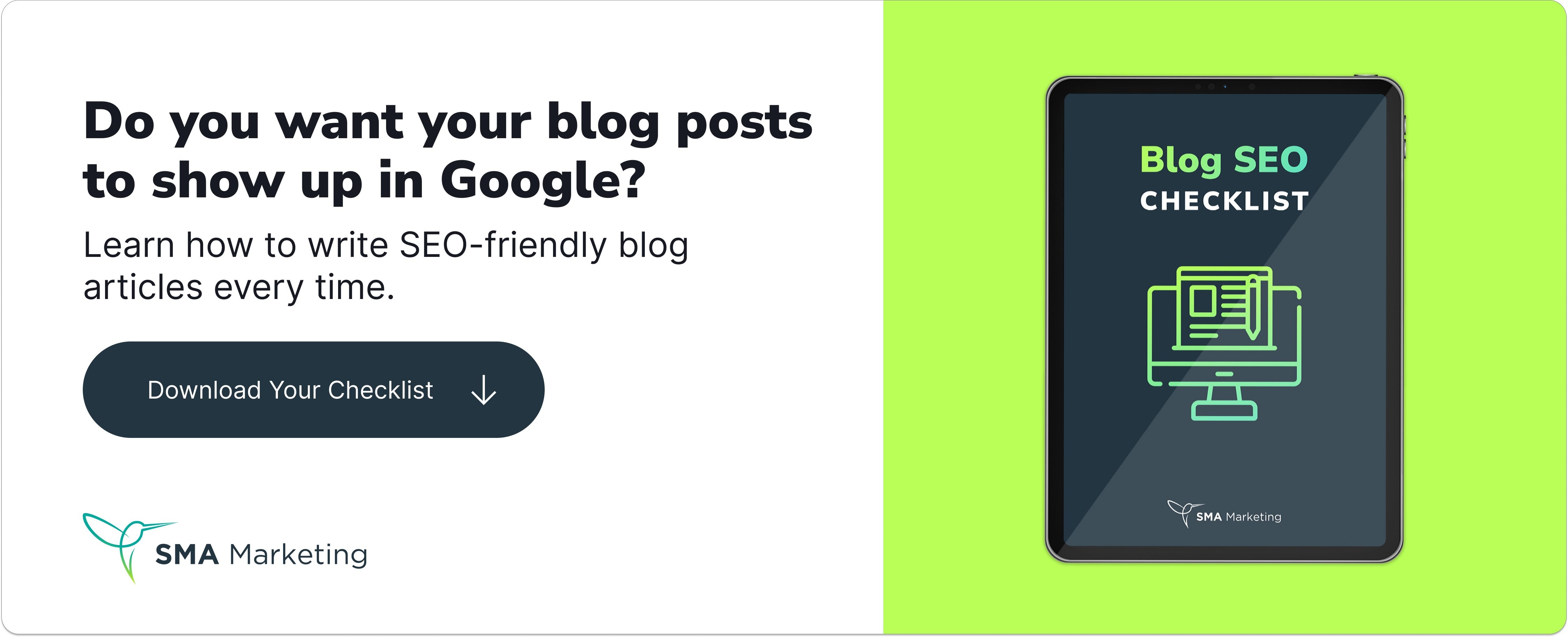Optimize Your Blog Posts Using an SEO Checklist [Free Template]
[ad_1]

At SMA Marketing, we are always looking for ways to refine our processes to produce the best quality content marketing services for our clients in the most efficient way possible.
We are currently in the process of building an in-house writing team to serve our clients’ content needs. It’s been a very rewarding endeavor, carried out by our exceptional Content Manager, Beth Walker. We’re hiring talented writers that we work with directly to produce high-quality content that connects with our clients’ target audience.
When you’re building a content team, there will be members with varying degrees of expertise in blog content optimization. It’s to be expected – not everyone has had the same training in SEO (search engine optimization) best practices.
It quickly became apparent that some training was needed to ensure everyone was following the same guidelines for on-page SEO optimization of blog content. Along with providing our writers with our Blog SEO Checklist document, we determined that a template they could use for each article would guide them through the blog SEO optimization process.
If you’re in search of an easy SEO checklist to follow when writing your blog posts, look no further. You’ll find access to your free copy of the template below.
Blog SEO Best Practices
The template covers the following blog optimization best practices:
Keyword in the Title
Make it easy for Google’s web crawlers to understand what your content is about by including the keywords in the article title. One of the first things the web crawlers look at is the title tag. If the keywords are at the beginning of the title, all the better.
Keep in mind when we say keyword or keywords, it could be a single word but is typically a string of words or a phrase commonly searched by your buyer persona.
Keyword in the First Paragraph
Again, you’re giving Google clues as to what the article is about by including the keyword in the first paragraph.
Link to Core Page in the First Paragraph
Try to link the keyword to a core page of your website in the first or second paragraph, if it makes sense contextually. You’ll want the link to be near the beginning of the article. This helps pass authority to your core pages which are the ones you are trying to boost in the search engine rankings. A core page, or pillar page, is one that provides high-quality content describing your services, solutions, or product.
At Least One External Link to an Authoritative Source
By linking your page to an external, credible, authoritative website, you are showing Google that your piece of content is related to a trustworthy piece of content. It lets Google know your content is trustworthy, as well. A few easy ways to link to an external site are:
- Include statistics and link to the source.
- Include terms that are relevant to your content and your industry and link to a website that defines that term.
- Include a link to a YouTube video tutorial of the subject in your article.
- Include an infographic from an authoritative site, using the embed code they provide.
Related article: Learn more about on-page optimization and external links, in Anatomy of an Optimized Page here.
Include Two Internal Links
You’ll be linking to a core page in the first paragraph, as described above. Also include links to other internal pages, such as other blog articles and landing pages. These links provide additional clues that the web crawlers use to determine whether or not your content answers the searchers’ questions.
Include the Keyword in a Heading
Google’s crawlers look at the H1, H2, and H3 tags of your page, those are the heading tags. The keyword will already be in the title tag, but make sure it’s also in at least one of your blog article headings. You could also include variations of the keyword in other headings. For example, note that in this article I used “SEO Checklist,” “Blog SEO Best Practices,” and “Why is Blog Post SEO Important?” in the headings. “SEO Checklist” is the keyword phrase for this article, but the other headings also relate to “blog SEO.”
Keywords in Image Alt Tag
When you add images, be sure you also add image alt text that contains relevant keywords to help Google serve up your image in search.
Keywords in the Body of the Article
You’ll want to sprinkle the article with relevant keywords and variations of it. We’re not suggesting keyword stuffing. Google will penalize you for that, and it appears unnatural to the user. What we are suggesting is that you include the keywords a couple of times in the article, where they fit contextually, and then also use LSI keywords throughout the article.
LSI (latent semantic indexing) keywords are words or phrases that are related to the target keyword that are often used by searchers when they are using search engines like Google. You can learn more about LSI keywords in SMA founder Ryan Shelley’s video What are LSI Keywords and How do They Impact Content Marketing and SEO.
Why is SEO Optimized Content Important?
Your blog content is one of the primary sources of content and context that search engines will use to determine the authority of your website. You are providing content that helps your audience, answers their questions, and adds value to your relationship with them. But, you need to help search engines like Google understand what your content is about and whether or not it’s relevant to searchers.
Give Google the clues to understand your blog content, and you’ll be one step closer to achieving your SEO goals.
Grab Your Free Blog Template and SEO Checklist
Our checklist is helping our content writers excel at writing blog articles that are SEO-friendly, while still serving the needs of our clients’ target audience. We are confident that it will help you, too.
We’ve put all of these tips together in an easy-to-use blog template and SEO checklist that you can start using today to optimize your blog posts for SEO and increase your search traffic. Download your copy below!
[ad_2]
Source link





